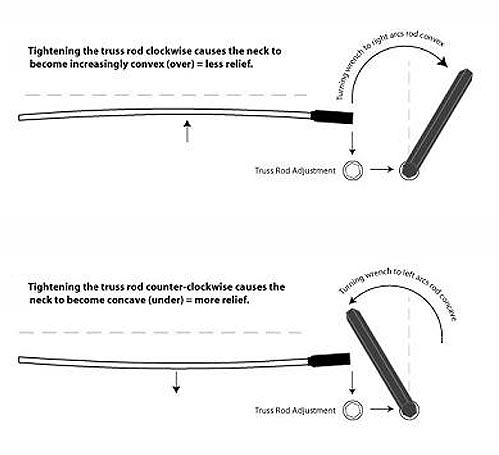What it is:
Although it might not look like, the overall tension that a set of strings generates is about 50 kg (depending on the gauge: can be much much more); therefore, a piece of wood relatively thin as a guitar neck wouldn’t stay even barely in place without twisting, bowing and bending under this kind of stress. This is what a trussrod is for: the trussrod is a steel bar inside the guitar neck that serves the purpose of stabilizing the neck in an optimal position by counterbalancing the string tension.
Even better, the related counter-tension applied by the trussrod is adjustable. So sometimes at the headstock, sometimes at the neck heel (and more rarely on the side of the neck heel), we’ll find the adjustment nut.
How it works:
Typically, when we have too much relief (1) in the central section of the neck (5th to 12th frets, let’s say), we have an up-bow. The playability won’t be the best and the intonation of the instrument will be all over the place.
On the other hand, if the neck is “too”straight or even has a bump in the central section (back-bow) (2), the guitar will have much fret buzz.
The ideal situation is having a “controlled” relief (3), a slight curvature on the neck so that our strings can obscillate freely when struck.

(image via)
The quantity of relief will impact, as said above, the overall playability but its adjustment goes along with the playing style. In general, the stronger the picking hand, the more relief you will need.
One of the best tip I got back in the days: if from a day to another your guitar doesn’t feel right anymore, do not try to fix it by changing the action. In fact, the culprit very likely will be the neck relief that changed on its own.
DIY tip:
Feared by many, attempted by few, the trussrod adjustment is not an overly risky or complicated task, but needs knowledge, tools and the right approach. Please bear in mind, the trussrod is not a pendulum clock we need to charge: the adjustment required on the trussrod nut is minimal.
If you want to try to adjust it, try this way. To measure the neck relief, you’ll need a straightedge long not less than 50 centimeters (or, even better, a notched straightedge) and a feeler gauge set: lie the straightedge in the middle of the neck, in the section between the D and G strings and check how much room there is between the edge of the straightedge and the top of the 8th frets (just to clarify: in the picture in the header I’m using a notched straightedge: that’s why the feeler gauge is on the fingerboard after the 8th fret; if you are using a normal ruler, you will need to check the clearance between the straightedge and 8th fret itself).
My opinion is that an optimal relief can go from 0.0 to 0.35 millimeters measured at the 8th fret, depending on the instrument, the state of the frets, the string action and playing style (as mentioned above, an energic strummer will need more relief than a lead player with a velvet touch). Tightening the trussrod nut reduces the relief, loosening increases it.

(image via)
Proceed for no more than 1/6 of a turn at a time (just for reference,10 minutes on the watch are 1/6 of a turn) and measure again.
Now, two very important must’s:
1) be gentle, do not force the nut if it’s too tight or you’ll risk to break the trussrod;
2) use the right key for this adjustment otherwise you would deform the trussrod nut.
